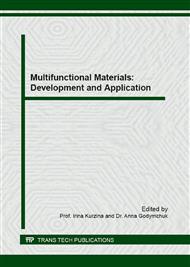[1]
S.N. Tabatabaei, H. Girouard, A.S. Carret, S. Martel, Remote control of the permeability of the blood-brain barrier by magnetic heating of nanoparticles: a proof of concept for brain drug delivery. J. of Contr. Release. 206 (2015), 49–57.
DOI: 10.1016/j.jconrel.2015.02.027
Google Scholar
[2]
M.B. Gawande, s A. Velhinho, I.D. Nogueira, C.A.A. Ghumman, O.M.N.D. Teodoro, P. S. Branco, A facile synthesis of cysteine–ferrite magnetic nanoparticles for application in multicomponent reactions—a sustainable protocol. Rsc Advances. 2(15) (2012).
DOI: 10.1039/c2ra20955a
Google Scholar
[3]
K.S. Martirosyan, C. Dannangoda, E. Galstyan, D. Litvinov, Screen-printing of ferrite magnetic nanoparticles produced by carbon combustion synthesis of oxides, J. of App. Physics, 111(9) (2012), 094311.
DOI: 10.1063/1.4711097
Google Scholar
[4]
J. Yang, F. Zhang, W. Li, D. Gu, D. Shen, J. Fan, D. Zhao, Large pore mesostructured cellular silica foam coated magnetic oxide composites with multilamellar vesicle shells for adsorption. Chem. Comm, 50(6) (2014), 713-715.
DOI: 10.1039/c3cc47813k
Google Scholar
[5]
A.E. Ermakov, M.A. Uimin, E.S. Lokteva, A.A. Mysik, S.A. Kachevskii, A.O. Turakulova, V.V. Lunin, The synthesis, structure, and properties of carbon-containing nanocomposites based on nickel, palladium, and iron, Russian J. of Phys. Chem. A, 83(7) (2009).
DOI: 10.1134/s0036024409070243
Google Scholar
[6]
V.R. Galakhov, S.N. Shamin, E.M. Mironova, M.A. Uimin, A.Y. Yermakov, D.W. Boukhvalov, Electronic structure and resonant X-ray emission spectra of carbon shells of iron nanoparticles, JETP letters, 96(11) (2013), 710-713.
DOI: 10.1134/s0021364012230075
Google Scholar
[7]
P.S. Postnikov, M.E. Trusova, T.A. Fedushchak, M.A. Uimin, A.E. Ermakov, V.D. Filimonov, Aryldiazonium tosylates as new efficient agents for covalent grafting of aromatic groups on carbon coatings of metal nanoparticles, Nanotechnologies in Russia, 5(7) (2010).
DOI: 10.1134/s1995078010070037
Google Scholar
[8]
J. Yan, M.C. Estevez, J.E. Smith, K. Wang, X. He, L. Wang, W. Tan, Dye-doped nanoparticles for bioanalysis, Nano Today, 2(3) (2007), 44-50.
DOI: 10.1016/s1748-0132(07)70086-5
Google Scholar
[9]
N. Chen, Y. He, Y. Su, X. Li, Q. Huang, H. Wang, C. Fan, The cytotoxicity of cadmium-based quantum dots, Biomaterials, 33(5) (2012), 1238-1244.
DOI: 10.1016/j.biomaterials.2011.10.070
Google Scholar
[10]
J. Peng, W. Gao, B.K. Gupta, Z. Liu, R. Romero-Aburto, L. Ge, P.M. Ajayan, Graphene quantum dots derived from carbon fibers, Nano letters, 12(2) (2012), 844-849.
DOI: 10.1021/nl2038979
Google Scholar
[11]
Q. Liu, B. Guo, Z. Rao, B. Zhang, J. R. Gong, Strong two-photon-induced fluorescence from photostable, biocompatible nitrogen-doped graphene quantum dots for cellular and deep-tissue imaging, Nano letters, 13(6) (2013), 2436-2441.
DOI: 10.1021/nl400368v
Google Scholar
[12]
S. Zhu, J. Zhang, C. Qiao, S. Tang, Y. Li, W. Yuan, B. Yang, Strongly green-photoluminescent graphene quantum dots for bioimaging applications, Chem. Commun., 47(24) (2011), 6858-6860.
DOI: 10.1039/c1cc11122a
Google Scholar
[13]
O. Kedem, W. Wohlleben, I. Rubinstein, Distance-dependent fluorescence of tris (bipyridine) ruthenium (ii) on supported plasmonic gold nanoparticle ensembles. Nanoscale, 6(24) (2014), 15134-15143.
DOI: 10.1039/c4nr04237a
Google Scholar
[14]
Eue Soon Jang, et al., Fluorescent dye labeled iron oxide/silica core/shell nanoparticle as a multimodal imaging probe, Pharmaceutical research, 31. 12 (2014), 3371-3378.
DOI: 10.1007/s11095-014-1426-z
Google Scholar
[15]
P.J. Goutam, D.K. Singh, P.K. Iyer, Photoluminescence quenching of poly (3-hexylthiophene) by carbon nanotubes, The J. of Phys. Chem., 116(14) (2012), 8196-8201.
DOI: 10.1021/jp300115q
Google Scholar
[16]
C. MingaLi, One-step and high yield simultaneous preparation of single-and multi-layer graphene quantum dots from CX-72 carbon black, J. of Mat. Chem., 22(18) (2012), 8764-8766.
DOI: 10.1039/c2jm32560h
Google Scholar
[17]
B. Unger, H. Jancke, M. Hahnert, H. Stade, The early stages of the sol-gel processing of TEOS, J. of Sol-Gel Science and Technology, 2(1-3) (1994), 51-56.
DOI: 10.1007/bf00486212
Google Scholar
[18]
A. Lesniak, A. Salvati, M.J. Santos-Martinez, M.W. Radomski, K.A. Dawson, C. Aberg, Nanoparticle adhesion to the cell membrane and its effect on nanoparticle uptake efficiency, J. of the American Chem. Society, 135(4) (2013), 1438-1444.
DOI: 10.1021/ja309812z
Google Scholar
[19]
Sun, S., Zeng, H., Robinson, D. B., Raoux, S., Rice, P. M., Wang, S. X., Li, G. (2004). Monodisperse MFe2O4 (M= Fe, Co, Mn) nanoparticles. J. of the American Chem. Society, 126(1), 273-279.
DOI: 10.1021/ja0380852
Google Scholar
[20]
J.H. Lee, S.P. Sherlock, M. Terashima, H. Kosuge, Y. Suzuki, A. Goodwin, H. Dai, High‐contrast in vivo visualization of microvessels using novel FeCo/GC magnetic nanocrystals, Magnetic Resonance in Medicine, 62(6) (2009), 1497-1509.
DOI: 10.1002/mrm.22132
Google Scholar
[21]
N. Chekina, D. Horak, P. Jendelova, M. Trchova, M.J. Benes, M. Hruby, E. Sykova, Fluorescent magnetic nanoparticles for biomedical applications. J. of Materials Chem, 21(21) (2011), 7630-7639.
Google Scholar
[22]
H. Andersson, T. Baechi, M. Hoechl, C. Richter, Autofluorescence of living cells, J. of microscopy, 191 (1998), 1-7.
DOI: 10.1046/j.1365-2818.1998.00347.x
Google Scholar


